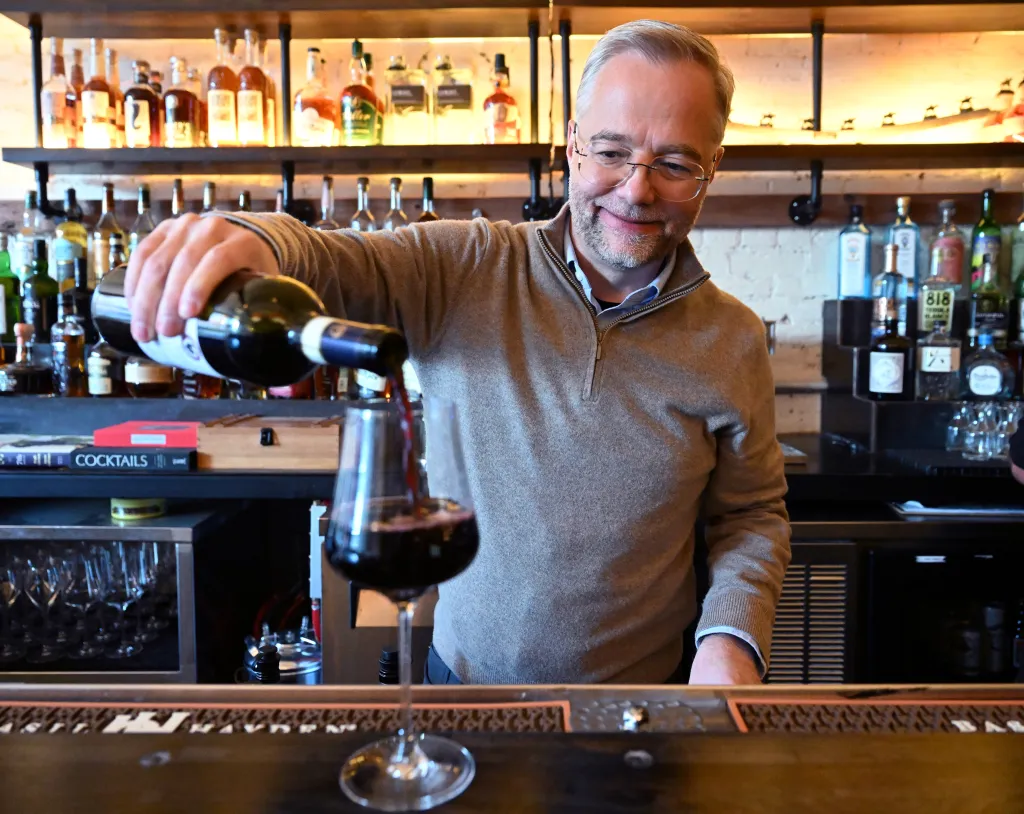Copyright Boulder Daily Camera

Tomas Zatloukalused to argue cases for a living as a lawyer in Prague, Berlin, Salzburg and Vienna. These days, you can find him arguing about issues more epicurean, like where the best olive oil comes from and why burrata tastes better when it’s imported. “Arguing” is a bit of an overstatement, as Zatloukal, who left his law firm and moved to Boulder after 25 years in courtrooms, is gracious, good-natured and more likely to ply his guests with a crisp glass of Carricante than try to win a point. In August, Zatloukal opened Vinca on Pearl Street, a second restaurant, following his Broomfield original, known for its wine list and its mastery of veal schnitzel. The menu blends ingredients from both America and Europe: tomatoes, greens and meat from Colorado farms, and olive oil, balsamic and burrata imported from Europe. Vinca turned three months old on Nov. 9, and, so far Zatloukal seems content with how it’s settling in. “We have amazing reviews and great feedback,” he said. “People here are excited about this kind of restaurant: tablecloths, good wine, real service.” Broomfield, he explained, runs on business lunches and corporate events, while Boulder runs on special occasions. “In Broomfield, guests come straight from the office,” Zatloukal said. “In Boulder, they come to celebrate things like birthdays, anniversaries or just a quiet date night.” The Boulder address, 1043 Pearl St., has seen more reinvention in recent years than the HBO Max logo. The address at 1043 Pearl St. has been home to several restaurants in recent years, from Pepper the Noshery (2019–20), Ash’Kara (2021–23), The Sophomore (2023–24), The Colorado Club Saloon (2024–25) and now Vinca. Zatloukal knows the track record. “It’s hard to hear that over and over,” he said. “Everyone keeps saying, ‘I hope you make it.’ But I think the spot is beautiful. The location is not the problem.” Turnover like that isn’t unusual in Boulder, where even a prime Pearl Street address can feel like a revolving door with better lighting. Rents are high, margins are thin and diners can be fickle. Still, Zatloukal doesn’t seem fazed. After all, he’s spent decades arguing in courtrooms across Europe, and a few tough judges over dinner service aren’t about to rattle him. Part of what makes Vinca so singular is Zatloukal’s meticulous, experiment-driven, scientific approach to his dishes. When he says Italian burrata tastes better than domestic, he can back it up with evidence. “I always ask my vendors to put two plates in front of me,” he said. “On one, their burrata. On the other, the one imported from Italy. I don’t know which is which. I taste them blind, and every time, I can tell which one is from Italy. It’s always the better one. It just tastes different. You can’t fake it.” Small, but important details, like olive oil, balsamic, and even Parmesan, are backed by this empiricism. “If the balsamic actually comes from Modena, if it’s aged right, it simply just tastes better,” he said. “I like to compare different ones, but I can always taste the difference between the real thing and the imitations.” However, Zatloukal is definitely not dismissive of local sourcing. “In the core, about 90% of our ingredients are local,” he said. “Then you have these little things that I like to bring from Europe.” He sources greens, produce and meat from Colorado farms. But when it comes to the details, he reaches across the Atlantic. He also reached across the Atlantic to perfect one of Vinca’s signature dishes, the schnitzel, which was developed with the help of an Austrian friend. Zatloukal said the two spent months testing and retesting the recipe until it reached what he considered perfection. “We were trying and trying again and again to bring the schnitzel to perfection,” he said. The final version follows tradition, made with veal, rather than the chicken or pork many American restaurants use, and served with mashed potatoes, cucumber salad and a spoonful of lingonberry jam, which — you guessed it — is flown in from Sweden. Perhaps the greatest gift on Vinca’s menu is the apple strudel. Not just any old apple strudel that you can get at an airport pastry case, but Zatloukal’s grandmother’s legitimate personal recipe, made with green apples, nuts and pâte feuilletée. Most people would have to travel to Austria (and back in time) to try it, but thankfully, the recipe has transcended both space and time and now appears, miraculously, at Vinca, topped with a cloud of whipped Chantilly cream. One of the things that makes Vinca feel distinct is how responsive Zatloukal is to his guests. He checks in at every table, inviting suggestions and acting on them. “Please let me know what you’d like to see differently or additionally,” he tells diners, a line he repeats almost nightly. “I get great feedback, and I take it seriously.” Some tweaks, he said, have been small. Others, like introducing traditional Austrian sweet gnocchi, a dish more familiar to European palates, reflect how adventurous Boulder diners can be. “People here are more open,” he said. “More relaxed. They’re willing to try new things.” Behind the line is executive chef Carlos Trujillo, whom Zatloukal has worked with for years. “Carlos is someone I trust completely,” he said. “He understands my standards, but he also brings his own creativity. We talk about every plate.” Together, they’ve fine-tuned the Boulder menu, keeping the core of what makes Vinca unique, but with enough flexibility to survive in a city where even the best concepts have a short shelf life. If the food tells one story, the wine tells another. “Wine is really my passion,” said Zatloukal. “When I open a wine from a certain region, I can see the hills, I can smell the air. For me, wine is more than an alcoholic drink. It’s culture, and it’s history.” Vinca’s wine list already comes with some pedigree. The Broomfield location has earned Wine Spectator’s Best of Award of Excellence three years running, winning the award in 2023, 2024 and 2025. Zatloukal brought that same philosophy (and many of those same bottles) to Boulder. Drawing from both European and domestic producers, the list includes a Carricante from Sicily, Grüner Veltliner from Austria, and a handful of domestic bottles that augment the flavors of schnitzel, scallops and strudel. He speaks about his list the way some people talk about their children: proud, slightly obsessive and ready to gush at length. “Everyone should try the Barolo we have by the glass,” he said. “It’s the king of Italian wines, and I priced it at $16 so everyone can afford one glass.” Zatloukal added: “For me, wine is a very important part of dining. If you have the right wine with the right food, it elevates both. It makes the food better, and the wine itself tastes better too. It’s like a marriage; one helps the other.” Downstairs, he’s already planning the next phase of the restaurant, which includes a transformation of the building’s basement into a wine cave. “We have a beautiful basement with old stone walls, and I want to turn it into a wine cave for private parties,” he said. “We’ll do tastings, pairing dinners, learn-how-to-taste-like-a-professional classes.” Zatloukal said he is aiming to have the cave open in December. For now, Zatloukal is content upstairs, moving between tables, refilling glasses and greeting guests like old friends — the lawyer-turned-restaurateur whose courtroom arguments have given way to more palatable acts of persuasion.



